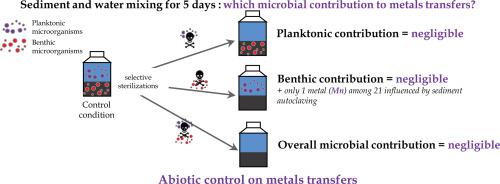Marine Chemistry ( IF 3.0 ) Pub Date : 2021-05-14 , DOI: 10.1016/j.marchem.2021.103981 Nicolas Layglon , Benjamin Misson , Nicolas Gallois , Sébastien D'Onofrio , Véronique Lenoble , Stéphane Mounier , Dario Omanović , Cédric Garnier

|
Marine sediments are a sink for trace metals but also a potential source during sediment resuspension events. Understanding the factor that regulates this uptake or release of contaminant is of prime importance. While the impact of abiotic processes has been widely studied, the quantitative influence of microbial activities on metal cycling during sediment resuspension events is still largely unknown. This study was designed to quantify such microbial contributions on the cycling of a suite of metals (Al, As, Ba, Co, Cr, Cs, Cu, Fe, Li, Mn, Mo, Ni, Pb, Rb, Sb, Sr, Ti, Tl, U, V and Zn) and evaluate the specific contributions of heterotrophic micro-organisms originating from either the seawater or the sediment. For that purpose, the sediment and seawater were selectively sterilized using either autoclave (sediment) or filtration under 0.2 μm (seawater) prior to be mixed for 5 days in darkness. Dissolved concentration in trace elements were measured over time, along with physical-chemical parameters. The pH in the different conditions decreased all along the experiments while the redox potential decreased during up to 4 days before increasing back to its initial value. Three groups of trace metals were identified: metals whose dissolved concentrations (1) increased (Al, Ba, Co, Cs, Cu, Mn, Mo, Ni, Pb, Sb, Tl, U and Zn) as a consequence of the transfer from sediment, (2) decreased (Cr, Fe and Ti) as a consequence of transfer onto sediment, and (3) remained unchanged over time (As, Li, Rb, Sr and V). The sterilization of either sediment and/or seawater did not have a statistically significant impact onto the dynamics of the physical-chemical parameters, nor onto the metals' behavior (except Mn). Our results demonstrate (i) that marine sediment autoclaving prior to mixing with seawater did not disrupt the behavior of metals in the seawater / sediment mixing over the 5 days of experiments and (ii) that the microbial activity had a negligible influence on the variation of physical-chemical parameters or metals' transfers over the mixing time.
中文翻译:

在海洋沉积物再悬浮过程中微生物异养对微量金属再动员的贡献可忽略不计——来自地中海城市化海湾的见解
海洋沉积物是痕量金属的汇,但也是沉积物再悬浮事件的潜在来源。了解调节污染物吸收或释放的因素至关重要。虽然非生物过程的影响已被广泛研究,但在沉积物再悬浮事件期间微生物活动对金属循环的定量影响仍然是未知的。本研究旨在量化此类微生物对一系列金属(Al、As、Ba、Co、Cr、Cs、Cu、Fe、Li、Mn、Mo、Ni、Pb、Rb、Sb、Sr、 Ti、Tl、U、V 和 Zn)并评估源自海水或沉积物。为此,在黑暗中混合 5 天之前,沉积物和海水使用高压灭菌器(沉积物)或过滤下 0.2 μm(海水)进行选择性灭菌。随着时间的推移测量微量元素中的溶解浓度以及物理化学参数。在整个实验过程中,不同条件下的pH均降低,而氧化还原电位在最多 4 天内下降,然后又恢复到其初始值。确定了三组痕量金属:溶解浓度 (1) 增加的金属(Al、Ba、Co、Cs、Cu、Mn、Mo、Ni、Pb、Sb、Tl、U 和 Zn)作为从沉积物,(2) 由于转移到沉积物上而减少(Cr、Fe 和 Ti),以及(3)随着时间的推移保持不变(As、Li、Rb、Sr 和 V)。沉积物和/或海水的消毒对物理化学参数的动力学和金属的行为(Mn 除外)没有统计学上的显着影响。











































 京公网安备 11010802027423号
京公网安备 11010802027423号